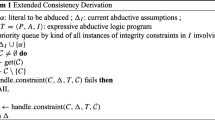Abstract
Annotated logic is a formalism that has been applied to a variety of situations in knowledge representation, expert database systems, quantitative reasoning, and hybrid databases [6], [13], [19], [20], [21], [22], [23], [24], [30], [33], [35], [36]. Annotated Logic Programming (ALP) is a subset of annotated logics that can be used directly for programming annotated logic applications [22], [23]. A top-down query processing procedure containing elements of constraint solving, called ca-resolution, is developed for ALPs. It simplifies a number of previously proposed procedures, and also improves on their efficiency. The key to its development is in observing that satisfaction, as introduced originally for ALPs, may be naturally generalized. A computer implementation of ca-resolution for ALPs is described which offers important theoretical and practical insights. Strategies for improving its efficiency are discussed.
Similar content being viewed by others
References
Adah, S., Subrahmanian, V.S., “Amalgamating Knowledge Bases II: Distributed Mediators”,Journal of Intelligent and Cooperative Information Systems, December, 1994.
Adah, S., Subrahmanian, V.S., “Amalgamating Knowledge Bases III: Algorithms, Data Structures, and Query Processing”, CS-TR-3124, University of Maryland.
Aït KaciH., BoyerR., LincolnR., NasrR., “Efficient Implementation of Lattice Operations”,ACM Transactions on Programming Language and Systems, 11, 1, 1989, 115–146.
BezdekJ. C., “Fuzzy models — what are they, and why?”,IEEE Transactions on Fuzzy Systems, 1, 1, 1993, 1–6.
BaldwinJ.F., “Evidential Support Logic Programming”,Fuzzy Sets and Systems, 24, 1987, 1–26.
BlairH.A., SubrahmanianV.S., “Paraconsistent Logic Programming”,Theoretical Computer Science, 68, 1989, 135–154.
Bundy, A., “A Science of Reasoning: Extended Abstract”,Proceedings of the Conference on Automated deduction, 1990, 633–640.
CohenJ., “Constraint Logic Programming Languages”,Communications of the ACM, 33, 7, 1990, 52–68.
Davey B.A., Priestley, H.A.,Introduction to Lattices and Order, Cambridge University Press, 1990.
FittingM., “Bilattices and the Semantics of Logic Programming”,Journal of Logic Programming, 11, 1991, 91–116.
T. Frühwirth, Annotated Constraint Logic Programming Applied to Temporal Reasoning,Proceedings of the Symposium on Programming Language Implementation and Logic Programming, 1994, 230–243.
Frühwirth, T., Herold, A., Küchenhoff, V., Le Provost, T., Lim, P., Wallace, M., “Constraint Logic Programming — An Informal Introduction”,Logic Programming in Action, 1992, 3–35.
Gaasterland, T., Lobo, J., “Qualified Answers that Reflect User Needs and Preferences”,Proceedings of the 20th International Conference on Very Large Databases, 1994, 309–320.
Hähnle, R., “Uniform Notation of Tableau Rules for Multiple-valued Logics”,Proceedings of the International Symposium on Multiple-Valued Logic, 1991, 26–29.
Jaffar, J., Lassez, J-L., “Constraint Logic Programming”,Proceedings of the 14th ACM Symposium on Principles of Programming Languages, 1987, 111–119.
JaffarJ., MaherM., “Constraint Logic Programming: A Survey”,J. of Logic Programming, 19/20, 1994, 503–581.
Jaffar, J., Michaylov, S., “Methodology and Implementation of a CLP System”, tutorial notes given in the Fourth IEEE Symposium on Logic Programming, 1987.
JaffarJ., MichaylovS., StuckeyP., YapR., “The CLP(R) Language and System”,ACM Transactions on Programming Languages and Systems, 14, 3, 1992, 339–395.
Kifer, M., Li, A., “On the Semantics of Rule-based Expert Systems with Uncertainty”,Proceedings of the 2nd International Conference on Database Theory, 1988, 102–117.
Kifer, M., Lozinskii, E., “RI: A Logic for Reasoning with Inconsistency”,IEEE Symposium on Logic in Computer Science, 1989, 253–262.
KiferM., LozinskiiE., “A Logic for Reasoning with Inconsistency”,Journal of Automated Reasoning, 9, 1992, 179–215.
Kifer, M., Subrahmanian, V.S., “On the Expressive Power of Annotated Logics”,Proceedings of the North American Conference on Logic Programming, 1989, 1069–1089.
KiferM., SubrahmanianV.S., “Theory of Generalized Annotated Logic Programming and its Applications”,Journal of Logic Programming, 12, 1992, 335–367.
KrishnaprasadT., KiferM., “A Theory of nonmonotonic inheritance based on annotated logic”,Artificial Intelligence, 60, 1, 1993, 23–50.
Leach, S., “D-resolution: A Semantically Based Query Processing Procedure for Annotated Logic Programming”, Honors Thesis in Computer Science, Bucknell University, May 1994. Computer Science TR94-2.
Leler, W.,Constraint Programming Languages: Their Specification and Generation, Addison-Wesley, 1988.
Lloyd, J.W.,Foundations of Logic Programming, 2nd ed., Springer, 1988.
LovelandD.W., “A Unifying View of some Linear Herbrand Procedures”,Journal of the ACM, 19, 1972, 366–384.
LuJ.J., HenschenL.J., “The Completeness of gp-resolution for Annotated Logics”,Information Processing Letters, 44, 1992, 135–140.
Lu, J.J., Murray, N.V., Rosenthal, E., “Signed Formulas and Annotated Logics”,Proceedings of the 23rd International Symposium on Multiple-Valued Logics, 1993, 48–53.
Lu, J.J., Nerode, A., Subrahmanian, V.S., “Hybrid Knowledge Bases”,IEEE Transactions on Knowledge and Data Engineering, to appear. TR93-14, Cornell University, revised March 1994.
Murray, N.V., Rosenthal, E., “Signed Formulas: A Liftable Meta-Logic for Multiple-Valued Logics”,Proceedings of International Symposium on Methodologies for Intelligent Systems, 1993, 275–284.
NgR., SubrahmanianV.S., “A Semantical Framework for Supporting Subjective and Conditional Probabilities in Deductive Databases”,Journal of Automated Reasoning, 10, 1993, 191–235.
Reed, D.W., Loveland, D.W., “Near-Horn Prolog and the Ancestry Family of Procedures”, presented at the symposiumLogic in Databases, Knowledge Representation and Reasoning at the University of Maryland Institute for Advanced Computer Studies, Nov. 1992.
SubrahmanianV.S., “Paraconsistent Disjunctive Databases”,Theoretical Computer Science, 93, 1992, 115–141.
SubrahmanianV.S., “Amalgamating Knowledge Bases”,ACM Transactions on Database Systems, 19, 2, 1994, 291–331.
Van Hentenryck, P.,Constraint Satisfaction in Logic Programming, MIT Press, 1989.
WeigertT.J., TsaiJ-P., LiuX., “Fuzzy Operator Logic and Fuzzy Resolution”,Journal of Automated Reasoning, 10, 1993, 59–78.
Wiederhold, G., “Mediators in the Architecture of Future Information Systems”,IEEE Computer, March 1992, 38–49.
Wos, L.,Automated Reasoning: 33 Research Problems, Prentice Hall, 1988.
Author information
Authors and Affiliations
Additional information
This material is based upon work supported by the NSF under Grant CCR9225037. A preliminary version of this paper appears in the proceedings of the International Conference on Logic Programming, 1994.
Rights and permissions
About this article
Cite this article
Leach, S.M., Lu, J.J. Query processing in annotated logic programming: Theory and implementation. J Intell Inf Syst 6, 33–58 (1996). https://doi.org/10.1007/BF00712385
Issue Date:
DOI: https://doi.org/10.1007/BF00712385




